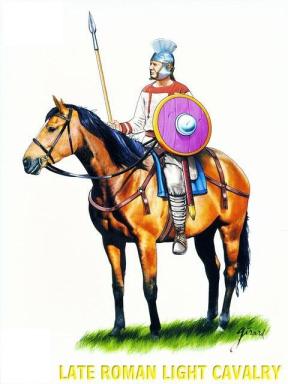The Roman Empire was encircled on all sides by enemies, who might come by sea as well as land, and needed to be defended by elaborate fixed fortifications as well as mobile armies. At the height of their power, Rome’s rulers preferred active to passive defence and maintained strong striking forces at strategic points generally behind rather than on the frontiers. It was only as their power declined and that of the outsiders grew that the border defences were thickened.
Whether on the decline or in the ascendant, however, Rome devoted great care to the gathering of intelligence. Caesar’s conquest of Gaul was as much the result of his superior use of intelligence as the legions’ superior fighting power. He took great trouble to assemble economic and regional intelligence, just as Alexander had done, and he was a coldly cynical assessor of the Gauls’ ethnic defects, their boastfulness, volatility, unreliability, lack of resilience; he was equally cold in exploiting the advantage his knowledge of their weaknesses afforded. He accumulated a detailed ethnographic knowledge of their tribal characteristics and divisions, which he used ruthlessly to defeat them. Quite apart from this strategic intelligence, however, he also had a highly developed system of tactical intelligence, using short- and medium-range units of scouts to reconnoitre up to thirty kilometres in advance of his main body, to spy out the land and the enemy’s dispositions when he proceeded on campaign. It was an important principle that the leaders of these units had immediate and direct access to his person.
Caesar did not invent the Roman system of intelligence. It was the product of several hundred years of military experience. Evidence for that is already given, by the time of the Gallic wars (first century BC), by the existence of established terms for the different categories of reconnaissance troops: procursatores, who performed close reconnaissance immediately ahead of the army; exploratores, longer-range scouts; and speculatores, who spied deeper within enemy territory. The Roman army also made use of local informers (indices), prisoners of war, deserters and kidnapped civilians. If not the inventor of the system, Caesar may, nevertheless, be credited with professionalising it and institutionalising some of its most important features, notably the right of direct access by scouts to the commander in person. He also, when necessary, went to see for himself, a dangerous but sometimes essential intervention. Ultimately, the crisis of the empire in the fourth century required the almost continuous presence of one of the emperors (there were latterly two, sometimes more) with the army, a contingency that, at Adrianople in 378, led to his death on the field, progressive disaster and the empire’s collapse. The Emperor Valens had been in close touch with his exploratores on the morning of the catastrophe and they had correctly reported the enemy’s strength and dispositions. What ensued substantiates a profound and enduring truth, that ‘military and political survival does not depend solely on good intelligence’.
Systems do not, however, much change, unless circumstances change, and there was little circumstantial change throughout the five centuries of the Roman Empire’s greatness (first century BC–fourth century AD). Reconnaissance throughout the period was by hearing and sight, communication by word of mouth or written despatch, speed of transmission at fastest by that of a fleet-footed horse. What was true of Rome remained true of the world for another 1,500 years.
The collapse of imperial government in the west in the fifth century AD entailed also the collapse of organised intelligence services and such ancillary services as the publication of guidebooks and cartography (though Roman maps are strange to us, since they usually took the form of route-charts rather than two-dimensional displays of territorial features, their disappearance was a serious loss to campaigning commanders). Worse by far was the progressive degradation and eventual and complete decay of the road system. The Roman roads were built primarily for the purpose of rapid, all-weather military movement and were maintained by the legions, which were as much engineering as fighting units. The dissolution of the Roman army led rapidly to the cessation of engineering work on such key elements of the Roman transport system as bridges and fords. The road network, of course, had not existed during the period of Roman conquest; Caesar had made his way through Gaul by interrogating merchants and locals and impressing guides. It was the roads, however, that had allowed Rome to defend its empire for five centuries and the break-up of their solid surfaces made long-range campaigning at speed impossible.
